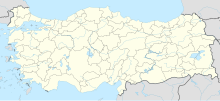Adana Ethnography Museum
| Adana Ethnography Müzesi | |
| Established | 1983 |
|---|---|
| Location | Ziyapaşa Bulvarı No:114, Adana, Turkey |
| Coordinates | 36°59′22″N 35°19′23″E / 36.989444°N 35.323056°E |
| Type | Ethnography |
| Area | 588,000 sq ft (54,600 m2) in 94 Galleries |
Adana Ethnography Museum, (Turkish: Adana Etnografya Müzesi), exhibits the ethnographic works, the inscriptions of Adana's landmarks and epitaph and gravestones of Adana's leading figures. The museum was opened in 1983 at the former Greek Church after Archeological Museum moved to its new location. As of May 2012, the museum is closed temporarily and will move to its location in the newly built Museum Complex in 2016.
At the garden, inscriptions and tomb stones in kufi, sülüs and nezih calligraphy are exhibited. In the southern and northern sections, female and male tomb stones in the Ottoman tradition from the 17th century are displayed including plain, coin headed, mecidiye type stones as well as stones with crowns shaped as fez, turban or in the baroque style. Tomb stones of some prominent people such as the Governor of Adana, Süleyman Paşazade Ahmet Pasha, the Local Administrator of Karaisali, Hasan Fevzi Bey, The Military Governor of Adana, Miratizade İbrahim Bey, the Treasurer of Adana, Mustafa Bey of Sophia, the Chief Forest Inspector Akif Efendi can be found among the collection.
In the western section, inscriptions from the Turkish-Islamic works are exhibited. The most prominent examples among them are the restoration inscriptions of Misis Inn, Adana Governor's Bureau, Bahripaşa Fountain, Taşköprü, Misis Bridge and the Ottoman State Seal.
The etnograhical works that are exhibited in different cases are;
Hand looms, and weaving instruments and tools (loom, shuttle, kirkit, bowspinning wheel, ılkıdır, kirmen, çıkrık) and kilim samples on the wall.
The tent is a black horsehair tent. Inside the tent, there are trousseau bags, felts and kilims on the floor, wall pillows, a lamp, a partridge cage, a hızman, a gun and a gunpowder case. In front of the tent a leather foot-wear (çarık), a wooden water cup, a stone mortar, a churn, and a spoon case. On the left side of the tent a nomad girl with a butter churn, a hand grinder and on the wall a kilim with a ram horn motif.
In the centre there is a brazier and a fully costumed nomad girl mannequin. On the wall there is a deer skin and a copper tray with inscriptions.
Samples of hand woven material from the nomadic tribes living in the Taurus mountains including kilims of various styles such as cicim, zili, sumak or soumak, ilikli and plain weaves, rug, saddle bag, prayer rugs and pillows. There are also felt prayer rugs and trousseau bags.
...
Wikipedia

